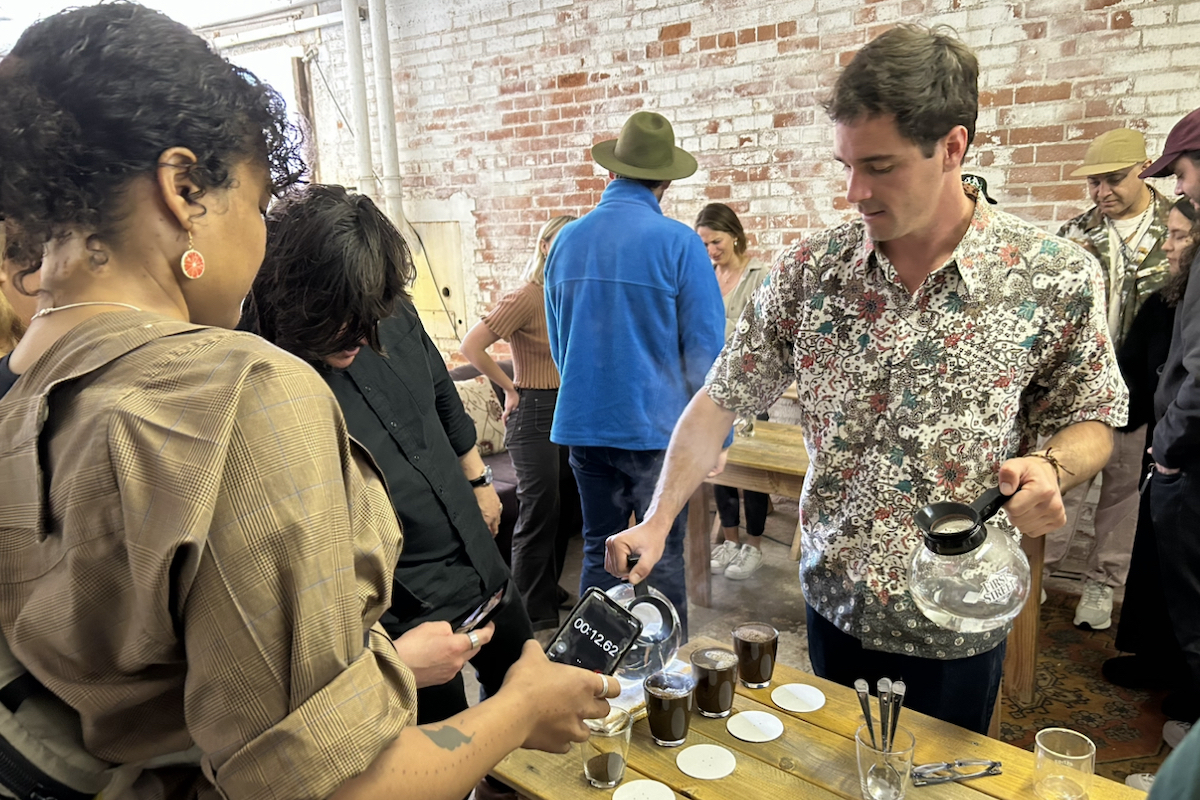Uncupping the Complexities of Coffee
There’s a Lot to Learn About What’s in Your Coffee

On the surface, coffee isn’t complicated. We pick up our favorite brand at the store and brew it at home, or we go to our favorite coffee company and order a drink. Three in four Americans drink coffee every day, according to a 2022 study.
But there is another layer to coffee that most haven’t ever seen. Beyond your favorite drink and type of roast, there are 120 types of coffee you can have. And here in Santa Barbara, you can learn all about it from coffee pro Griffin Hall, who works at FRINJ Coffee.

On Saturday, April 15, Hall hosted a coffee-cupping workshop, the third in an ongoing series of coffee skills events. This workshop focused on “cupping,” which is a fancy way of saying “tasting.” Hall is a certified Q-Grader of coffee and has taught the different methods of tasting. He hopes to run a workshop every two weeks including other skills like roasting and brewing coffee.
Learning coffee skills usually isn’t cheap — becoming a Q-Grader is $2,000, and even regular intro-level classes are upward of $500. Hall’s workshops are only $25 and take place locally at the Stik N Stuk Creative Space in the Funk Zone, where he gives step-by-step guidance on the proper coffee cupping technique.
“Coffee cupping is like wine tasting for coffee, but it includes smelling the dry fragrance,” Hall explained at the beginning of his presentation. “I wanted to put this on because a lot of us drink coffee, but we don’t really know what to look for.”
You start with the coffee grounds and what they smell like. You’ll want to know if it’s got a strong or weaker fragrance, and you want to try to pinpoint what it is — maybe it smells like flowers, caramel, or fruit.
Once you’ve locked into the “notes” of your coffee, you pour your hot water (200º Fahrenheit) directly in with the grounds — filtering it can alter the taste at this stage. You’ll want to wait anywhere from three to five minutes, according to Hall, and you’ll let a “crust” build on top of your coffee.

You break this crust with a spoon, holding it close to your face so you can take a deep breath. “This is a big aromatic release moment,” Hall said, bending over the table to demonstrate the proper technique. “You’re going to get some different aromas than you would in the dry fragrance.”
You remove the crust with the spoon, allowing the coffee to cool more so you can get all of the flavors. “As the coffee cools, you’re going to notice that it changes, and you actually get most flavor out of a lukewarm temperature,” Hall said.
And a small amount of coffee will do. When tasting, you need just enough to coat all sides of your mouth. Some flavors will sit more on the sides or tip of your tongue, and some flavors stay on your tastebuds longer than others due to their acidity.
Almost everyone at the workshop was a beginning “cupper,” save for a few professional coffee roasters that attended for the experience. Nick Brown had attended the previous workshop on processing techniques of coffee and felt better prepared for the cupping. “I used to just buy the pre-ground coffee at the store; it seemed convenient,” he said.
Hall featured four different coffees. One was a Colombia Pink Bourbon coffee that was infused with orange peels and tartaric acid from Luminous with notes of orange jasmine, chocolate, and malic acidity.

The second was an acidic Kenyan coffee made by Dune, with notes of blackberry, grapefruit, and caramel. The third was an Ethiopian coffee made in Ventura at Coffee + Clay, with notes of strawberry, peach, and caramel — the fan favorite of the workshop. The last was a Sumatran Wet Hulled coffee with notes of honey, pumpkin spice, milk, and chocolate.
In addition to the specifics of the coffee he brought, Hall talked about coffee’s origins: how it’s grown, farmed, transported, and produced. In future workshops, Hall will be teaching brewing techniques.
Hall spoke of some of the benefits of learning cupping. “There’s so much coffee in the world that has so many different flavors,” Hall said. “I think it’s pretty cool if we can tap into a bit of understanding about what our own preferences are so we can buy the best coffee for ourselves.”




You must be logged in to post a comment.